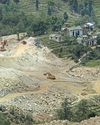The Aral Sea has shrunk to a fourth of its size. Neha Mungekar travels to Uzbekistan and recounts how it remains a living sample of a monumental human-made ecological catastrophe
IN MODERN times, the health of an economy is deemed far more vital than that of the ecology. Re-routing rivers, realigning water bodies, focusing on mono culture cultivation, creating cities next to transport corridors and then transporting water to places with scarce groundwater has become the norm across the world. Sudden prosperity may validate this development pathway, but the irrevocable damage to nature is catastrophic. Aral Sea is one such story.
In the 1960s, the Aral Sea region used to support a thriving fishing industry. Even earlier, the Amu Darya and Syr Darya river basins, which used to feed this inland lake, provided water to the oasis towns that gave birth to the historic Silk Route. During the Soviet rule, Uzbek towns near the Aral Sea were forced to shift their livelihood to cotton mono culture farming. Ill Conceived Soviet irrigation schemes reduced the water flow from the rivers needed to replenish the Aral Sea.
Today, the lake—which was called a sea due its sheer size and salinity—has reduced to a mere 25 per cent of its original size. From being as big as the state of Punjab, it is now smaller than the size of Goa because of the re-routing of Amu Darya and Syr Darya to give impetus to cotton production. Although the Aral Sea disaster—a human made environmental catastrophe—was realised in the late 1990s, its consequences are becoming even more evident today.
In the 1960s, the depth of the lake was 68 metres. Today, it is less than 10 metres. A relatively shallow water level spread across a large surface area has led to faster evaporation. This has caused over 90 per cent loss in the volume of water in the last six decades. Once the world’s fourth-largest lake, it now hosts travellers who visit to witness the apocalyptic landscape.
Layered problems
この記事は Down To Earth の August 1, 2017 版に掲載されています。
7 日間の Magzter GOLD 無料トライアルを開始して、何千もの厳選されたプレミアム ストーリー、9,000 以上の雑誌や新聞にアクセスしてください。
すでに購読者です ? サインイン
この記事は Down To Earth の August 1, 2017 版に掲載されています。
7 日間の Magzter GOLD 無料トライアルを開始して、何千もの厳選されたプレミアム ストーリー、9,000 以上の雑誌や新聞にアクセスしてください。
すでに購読者です? サインイン

A SPRIG TO CARE FOR
Punarnava, a perennial herb, is easy to grow and has huge health benefits

DIGGING A DISASTER
Soapstone mining near Dabti Vijaypur village has caused many residents to migrate.

REVIEW THE TREATMENT
Several faecal sludge treatment plants in Uttar Pradesh suffer from design flaws that make the treatment process both expensive and inefficient

MAKE STEEL SUSTAINABLE
As India works to double its GDP by 2030, its steel industry must balance growth with sustainability. By embracing policies like the Steel Scrap Recycling Policy 2019 and adopting green technologies, India is paving the way for a more sustainable future in steel production

Can ANRF pull off the impossible for India?
Anusandhan National Research Foundation is expected to reorient India's innovation goals but funding issues, old mindsets remain a drag

TROUBLED WOODS
Forests are a great bulwark against climate change. But this is fast changing. AKSHIT SANGOMLA travels through some of the pristine patches of the Western Ghats to explore how natural disturbances triggered by global warming now threaten the forest health

BLINDING GLOW
The science is clear: increased illumination has damaging consequences for the health of humans, animals and plants. It’s time governments introduced policies to protect the natural darkness and improved the quality of outdoor lighting.

GROUND REALITY
What happens when the soil loses the ability to grow healthy, high-yield crops on its own?

GM POLICY MUST BE FARMER CENTRIC
On July 23, the Supreme Court of India directed the Union government to develop a national policy on genetically modified (GM) crops for research, cultivation, trade and commerce through public consultation.

Vinchurni's Gandhi
A 96-year-old farmer transforms barren land into a thriving forest in drought-prone region of Satara